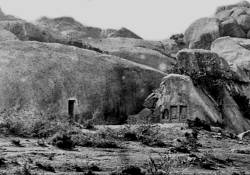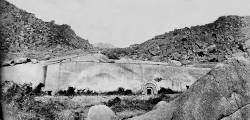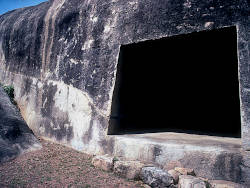Barabar Caves
Useful Information


| Location: |
36 km north of Gaya, 25 km south of Jehanabad.
The road is bad but possible with a normal car.
(25.004845, 85.066537) |
| Open: |
Site: no restrictions. Caves: all year daily 6-18. Museum: all year daily 6-18. [2020] |
| Fee: |
free. [2020] |
| Classification: |
 Cave Church Cave Church
|
| Light: | bring torch |
| Dimension: | |
| Guided tours: | self guided, D=3-4 h. |
| Photography: | allowed |
| Accessibility: | no |
| Bibliography: |
E. M. Forster (1924):
A Passage to India,
Edward Arnold (UK), Harcourt Brace (US), 04-JUN-1924.
epub download
|
| Address: | Barabar Caves, Barabar Museum, Barabar, Barabar Hill Rd, Bihar 804405, Tel: +91-612-2234194. |
| As far as we know this information was accurate when it was published (see years in brackets), but may have changed since then. Please check rates and details directly with the companies in question if you need more recent info. |
|
History
| 200 BC | caves excavated. |
Description

The बराबर म्यूज़ियम is a new museum which was erected at the road. It provides an introduction and detailed information about the caves. You should first see the museum before you go to the caves.
The Barabar Hill Caves are the oldest surviving rock-cut caves in India, or probably the second oldest after Son Bhandar Caves in Rajgir are a bit older. The dispute is not settled yet. The were cut during the Maurya Empire (322–185 BCE). Four are located in the quartzite gneiss monolith named Barabar hill, Karan Chaupar, Lomas Rishi, Sudama and Visvakarma. There are three more 2 km away in Nagarjuni Hills which are named Nagarjuni Cave. Together the group of caves is called satghar or satgharwa which means seven houses.
King Ashoka reigned the Maurya Empire between 273 BC and 232 BC. He and and his son Dasaratha were Buddhists but their state had religious freedom. Several Jain sects and branches and other religious and philosophical trends flourished during their reign. One was called Ajivika (Ājīvika) and was actually not a religion but an atheistic philosophic movement. The father of Ashoka was a believer of this philosophy and during Ashoka’s reign its popularity reached a peak. Ashoka granted three of the caves to Ajivikas during his reign.
The main feature of the caves in the book A Passage to India by E M Forster are the strange echo effects. Those actually exist and are caused by the form of the vault and the polished walls. Most likely the walls were polished to create this echo effect. The reverberation lasts several seconds and the initial sound changes constantly.
This is Naxalite bandit country and visitors are strongly advised not to travel alone, but go to the police station and organise an armed escort.
Two of these caves were made famous by E M Forster in his book, and later in the film, A Passage to India. He called them the Marabar Caves and they contain Ashokan inscriptions.
The caves consist of temples and sanctuaries hacked out of huge granite outcrops. Their interior surfaces are remarkably smooth, and some are thought to have served as retreats for Jain monks.
Drawing inspiration from ordinary huts, the Barabar Caves are designed to look as if they have been made of wood. The facade of the Lomas Rishi Cave, which is sculpted to resemble lattice screens, is the first available example of the famous Buddhist Chaitya Arch style in India.
On the southern face of Barabar hill lies the earliest cave shrine known as the Sudama Cave, known in ancient times as Nigoha-kubha or Banyan Tree Cave. This cave, excavated in the 12th regal year of Ashoka or 2 BC is a two-chambered structure and the interior surface of the cave is polished to a high degree and gives an impression of a layer of glass laid on stone.
Karan Chopar, a single-chamber-structure with a vaulted roof and simple opening in the rock face, lies to the north of this cave. This cave was chiselled out in the 19th regal year of Ashoka. An early inscription refer to it as the Supriya Cave while later inscriptions describe it using various names like Bodhimula, which means The Root of Intelligence, Daridra Kandara, The Cave of the Poor, etc.
About 1000 meters east of this cave lies the fourth two-chambered cave: This is the Vishva Zopari Cave which was excavated in the 12th regal year of Ashoka.
Text by Tony Oldham (2003). With kind permission.
 Search DuckDuckGo for "Barabar Caves"
Search DuckDuckGo for "Barabar Caves" Google Earth Placemark
Google Earth Placemark Barabar Caves - Wikipedia
Barabar Caves - Wikipedia Barabar Caves (visited: 11-NOV-2020)
Barabar Caves (visited: 11-NOV-2020) Index
Index Topics
Topics Hierarchical
Hierarchical Countries
Countries Maps
Maps